There’s some (big) thing you need know before getting these gorgeous workhorses.
By Editor Team | February 6, 2022
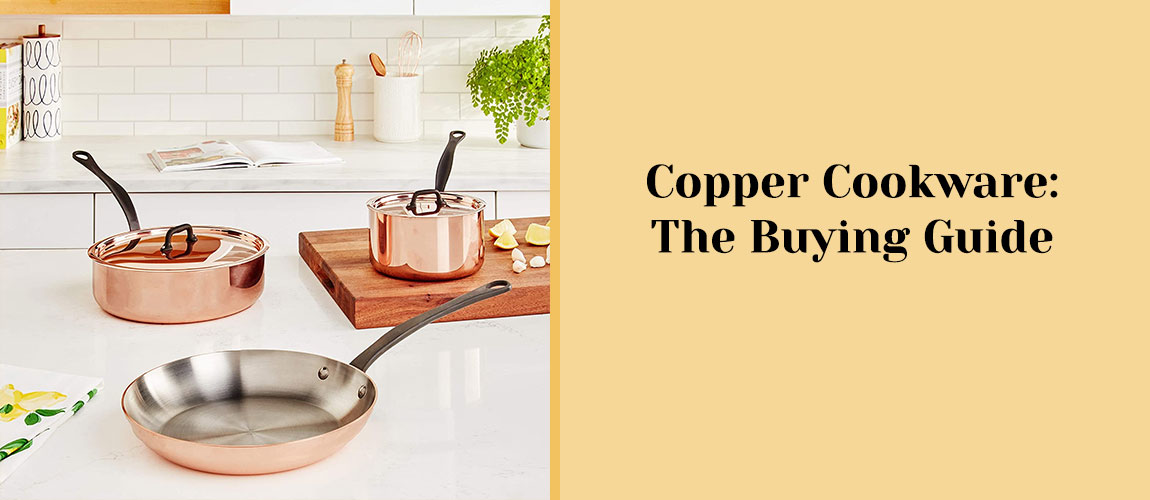
Not only cooks, but the gleaming copper cookware is also inevitably attractive. Just in the same way a luxury sport car does, it’s never cheap—either for its appearance, cooking ability and price tag. Copper cookware isn’t just beautiful. With the unbeatable heat conductivity (both fast and evenness), it’s a powerful tool for handling many specific recipes. Probably, that’s why many people can’t stop wishing for these gorgeous pieces for the kitchen, at least a small saucier or a jam pot.
Copper is a more expensive option than stainless-steel, nonstick, ceramic, and cast-iron stuffs. Moreover, it’s not that easy to choose. Above from the extravagance, it has some specifics that affect to cooking quality, long-term cost for lining and maintenance. These’re genuinely recommendations you should know before getting it.
Copper has been a part of many civilizations—through our long history for over 10,000 years. There’s evidence that copper was popularly used in the Middle East, Ancient Egypt, Mesopotamia, Roman, China, Mexico and India.
For cooking world, copper is widely recognized from French cuisines and the high-quality craftmanship of their pots and pans. Many antique pieces from 1800s to pre-World War II are made of extra-thick copper and a tin lining, with beautiful baroque brass or cast-iron handles. These vintage products are often thicker than today commercial standard since usually made to be 3mm thick, and sometimes close to 4 or even 5mm.
By mid-century, it gains a massive popularity again among French chefs as outfiting to create batterie de cuisine, or the range of tools used in a professional kitchen for desserts, pastries and confectionery—Julia Child’s cooking show broadcasted the 1960s to 1990s is an illustrious icon. These days, there’re many ranges of copper tools from 1800s-French-established manufacturers, like Mauviel, to modern newcomers.
Copper cookware is not cheap—in fact, it’s very expensive—in terms of everything. Either professional chefs or serious home cooks, copper is renowned for its exceptional heat (and electric) conductivity. It heats quickly and spreads evenly all over the cooking surfaces. When taking it off the stove, it cools nimbly fast.
The question is: worth it? It depends. Like a sports car, it’s fantastic but seriously expensive. Whether a pot, a pan or a specialty, a reasonable piece will beg you at least $300 to $1,000—at this budget, you can buy a good standard set or two (or maybe three). So, for occasional cooks, maybe considering a decent set of ceramic, nonstick or stainless-steel seems to be more sensible.
But, if that spontaneously fast, superb temperature control is your strong desire, get it. Copper outstrips for anything that needs immediate heat or reaches a specific consistency—searing, jump sauteing, delicate proteins, like fish and seafood. Also, it’s perfect suit for working with sauces and sweets, like jams, caramel, chocolate and candies. It’s undeniably stunning, as well.
Not necessary to buy the whole set, it’s worth to collect some good workers, like sauciers, skillets and rondeau pans, or even a fondue set.
Scientifically speaking, copper is a superb heat diffuser due to superior thermal conductivity to most materials used for pots and pans these days.
According to the expert test, metallurgists use thermal conductivity (in Watts per meter-Kelvin, W/(m.K)) for measuring a material’s ability to conduct heat at room temperature. The display shows how excellent the copper is:
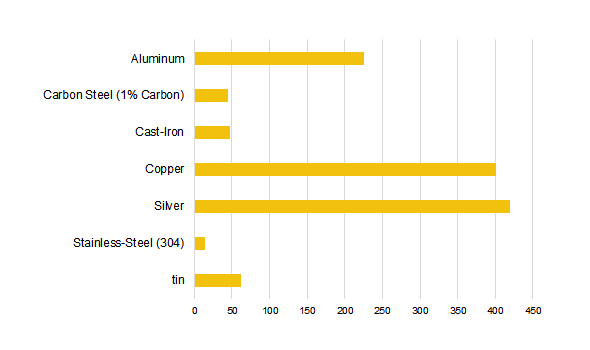
The thermal conductivity of common materials for cookware (source)
As you can see, at 401W/(m.K), copper is the highest among non-noble metals, like silver—almost twice that of aluminum (225), nearly 8 time that of cast-iron (48), 9 times that of carbon-steel (45) and much higher than stainless steel (14).
This means: when heated, copper cookware will spread heat evenly and consistently across all over the pan and up the sides—giving even, quick cooking and energy savings.
Like most cookware, the thickness of the copper in a pot is dramatically the single factor to indicate its performance, as well as its cost. Thin copper pans get blazing hot too fast even on medium heat that can easily lead to overheat and burn food. In contrast, thick copper pans response heat more slowly and hangs the hot steadier, which helps delivering even results and better browning meat, sauteing vegetable and delicate sauces.
The thickness of copper lining plays a crucial role for heat performance of the pans. The thicker pans are likely more useful for a great many more.
So, the more thickness, the better performance?
Julia Child said in her book, “Mastering the Art of French Cooking”, that to get the full benefit of copper it must be 1 eighth of an inch thick—that is 3.175mm. However, many experts, like Serious Eats and Vintage French Copper contrarily believe that the copper pans that are thicker than 3mm is rather more emotional than practical. These might feel good to own and use but they aren’t necessarily better for cooking, even for a vintage piece.
Moreover, the thick pans can be heavy and make more difficult to use. An ultra-thick restaurant-grade copper pan—thicker than 3.5 mm—should be about as heavy as the cast-iron counterpart. This can burden your wrists and feels unwieldy when lifting, cooking and cleaning up.
A heavy pan is something that you either like or not. But, if you expect for a really light pan, it’s better to consider an aluminum or stainless-steel pan.
Here’s the recommended thickness of copper cookware for common practice:
Less Than 2mm
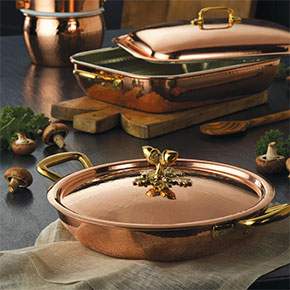
Light duty/decorative pieces
With 2mm thick less (especially less than 1.5mm), it doesn’t have enough mass to deal with average home burners. This makes the temperature too fluctuate to control—easy to get overheat, food burn and uneven results. It tends to get a risk of ruining and foaming the tin lining, as well.
Deservedly, it’s a gorgeous serving piece on the table.
Yet, some specialties, like fish poacher, braiser or pieces that are liquid cooking are acceptable since heat can absorb and spread more effectively in water. Pick ones that is thick than 1.5mm.
2 to 3mm
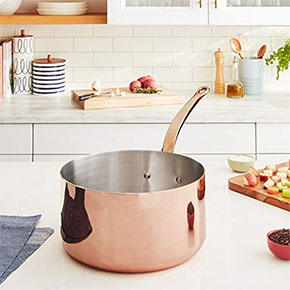
Efficient/Everyday Cooking
To utmost utilize to benefit of copper, the pots and pans should be around 2.5 to 3mm thick—this is ideal balance of performance, weight and value. At this range, the massive is enough for effective thermal absorption and diffusion from a modern home cooktop.
Also, while these tools are sturdy enough for firmly placing on the cooktop and oven, they’re too heavy to handle, even for home cooks.
More Than 3mm
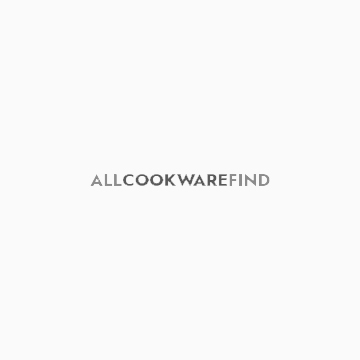
Affective Cooking/ Collectibles
Though, in the cookware world, the thicker conductor is preferred to the thinner ones, there’s an appropriate range. The super-thick copper pans (more than 3mm), mostly antique pieces, don’t have value-added functional benefit. Whether for the aesthetic collection, self-pleasure or investment, these pieces cost you more dollars and hefty weight to lift.
Rondeaus, brasiers or other pans that designed for dry cooking are a little exception, however. They can well utilize the thickness of conductive materials.
Still, there’s a thing to remind. Even though in the same set, each pot and pan mightn’t have the same thickness and, moreover, many online companies don’t declare the specific thickness of each pan. For the reason, the weight of the pieces might be a possible clue for knowing this. You can check estimated thickness of your pan from the list.
More facts about the current production:
Copper is highly reactive. Acid foods, such as vinegar, lemons and tomatoes can filter copper into the food and cause an off metallic taste. When consuming certain a lot of copper, copper toxicity can occur. That’s why most copper cookware is lined.
Actually, the type of liner material is one of the most important factors to consider before buying copper pots and pans. Stainless steel and tin are used for common liners, while silver, nickel and aluminum are rarely found in some crafts.
Which lining is the best?
Again, it depends. Each metal liner has specific character—heat resistance, thermal distribution, nonstick surface and maintenance.
For example, tin, a traditional way, is preferred for many chefs for its natural nonstick surface and high heat transmission while easy to get scratching and has forced to use under 450°F. While stainless-steel needs less maintenance and allows for high temperature cooking but is more prone to stick. For full discussion, see How to choose the copper lining material.
Copper cookware is a dream stuff that many people want to own and experience. It’s likely to be one of the most expensive cooking tools in the kitchen. While copper mightn’t be fit for everyone, professional chefs, patisseries, and skilled home chefs know that it worth the hype.
As allowing for control heat precisely, a thick copper pan can excellently sear thick meats, handle some delicate recipes like seafood and fish and make delicate sauces excellently, as well as is perfectly fitting for making sweets like caramel and chocolate. Moreover, it’s a gorgeous display in your kitchen and on the dining table.
Only if you’re not using an induction burner and willing to take more time to care for your copper pan, it can last to your next generations and really make it a precious investment.